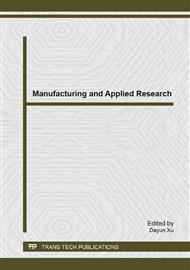[1]
Koren Y, Hu S J, Weber TW. Impact of manufacturing system configuration on performance [J]. CIRP Annals-Manufacturing Technology, 1998, 47(1): 369-372.
DOI: 10.1016/s0007-8506(07)62853-4
Google Scholar
[2]
Zhong WP, Maier-Speredelozzi V, Bratzel A, et al. Performance analysis of machining systems with different configurations[C]. Proceedings of the 2000 Japan-USA Flexible Automation Conference, 2000, 783-790.
Google Scholar
[3]
Maier-Speredelozzi V, Hu SJ. Selecting manufacturing system configurations based on performance using AHP[J]. Technical Paper, Society of Manufacturing Engineers, 2002, 1-8.
Google Scholar
[4]
de Lamotte FF, Berruet P, Philippe JL. Evaluation of Reconfigurable Manufacturing Systems configurations using tolerance criteria[C]. IEEE 32nd Annual Conference on Industrial Electronics, IECON 2006, Paris, 2006, 3715 -3720.
DOI: 10.1109/iecon.2006.347765
Google Scholar
[5]
Huang N, Lin Y. Chaining set partitions with applications in manufacturing system configuration planning[J]. International Journal of Operational Research, 2009 6(3): 380-404.
DOI: 10.1504/ijor.2009.026939
Google Scholar
[6]
Ko J. Design and analysis of complex configurations of manufacturing systems[D]. University of Michigan, (2006).
Google Scholar
[7]
Webbink RF, Hu SJ. Automated generation of assembly system-design solutions[J]. IEEE Transactions on Automation Science and Engineering, 2005, 2(1): 32-39.
DOI: 10.1109/tase.2004.840072
Google Scholar
[8]
SUN Shuling, XU Yinlong. Introduction to combinatorial mathematics[M]. Hefei: China science and technology press, (2010).
Google Scholar
[9]
Spicer P, Koren Y, Shpitalni M, et al. Design principles for machining system configurations[J]. CIRP Annals manufacturing technology, 2002, 51(1): 275-280.
DOI: 10.1016/s0007-8506(07)61516-9
Google Scholar


